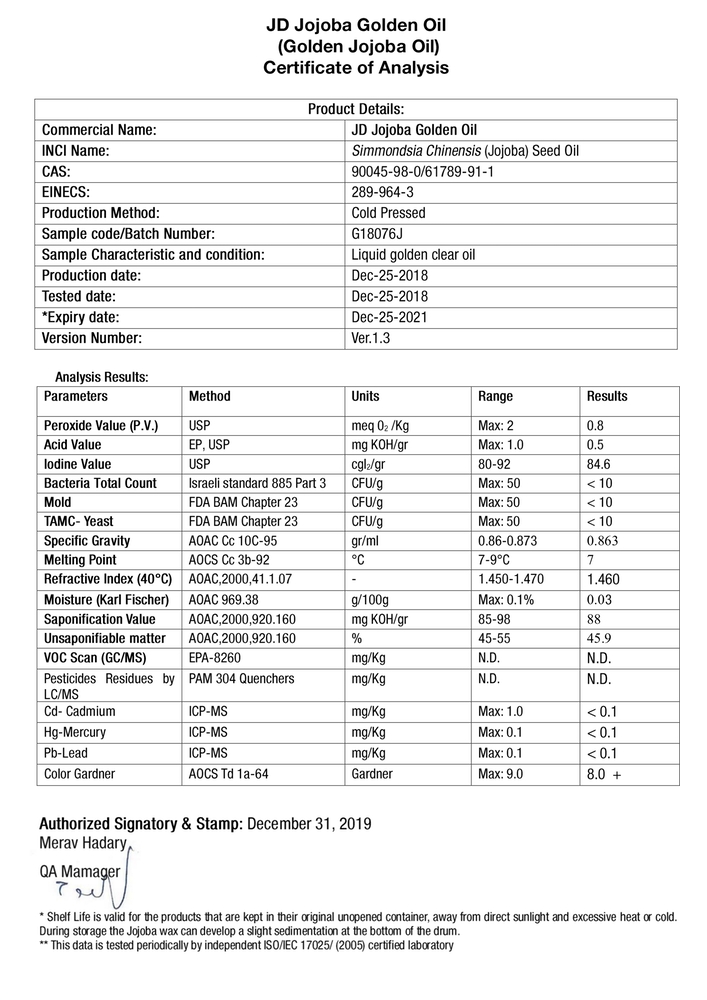Jojoba oil is extracted from the nuts of the Simmondsia chinensis plant and is strictly speaking not an oil but a wax. Unlike other vegetable oils, jojoba oil is very similar to our own sebum, which makes it an ideal skin care product. It is extremely rich in vitamins, it draws almost without residue into the skin, does not greasy, stimulates wound healing and protects the skin with a natural SPF of 4. It contains only a small amount of triglycerides and hardly reacts to oxygen or other environmental influences, which keeps it up to 25 years. Jojoba oil is yellowish and has a nutty spicy smell. The plant is native to the Sorona desert between Arizona, USA and Mexico.
Jojoba oil provides long-lasting moisture without clogging skin pores. Its long-chain fatty acids, known as wax esters, resemble the skin's natural sebum. Therefore, they strengthen the protective layer that the skin sebum forms. Fat-dissolving enzymes break it down slowly. That's why jojoba oil keeps the skin supple for a long time. Thanks to the wax esters, jojoba oil does not leave a greasy film on the skin. The fatty acids can penetrate into deeper skin layers and transport the vitamin A and E as well as minerals contained in the oil to these areas.
Vitamin A promotes the development of cells and metabolism in the skin. Vitamin E helps to form collagen, structural proteins for the connective tissue. This tightens the skin and relieves scars. In addition, Vitamin E destroys free radicals that cause cell damage. Your skin absorbs jojoba oil especially well when you apply it to moist skin after showering. You can simply spread it with your fingers and then lightly massage it in. The oil distributes particularly well if you spray it on. Jojoba oil takes about 20 minutes to completely absorb into the skin. Afterwards, you can apply regular day cream or your usual night care to your face.
Jojoba oil helps restore the skin's natural balance in case of acne. Cleansers, exfoliators, and acne creams for skin impurities strain and dry out the skin. This prompts the skin to react with increased sebum production, causing more sebaceous glands to clog - a vicious cycle. Jojoba oil is the ideal skincare for acne because it resembles the skin's natural sebum. Unlike glycerin-based oils, jojoba oil does not form a greasy film. Experts call it non-comedogenic, meaning it does not lead to the formation of blackheads (comedones).
The wax esters penetrate deep into the skin. There, vitamins A and E promote skin renewal by boosting collagen formation and metabolism. This supports wound healing and counteracts inflammation caused by Propionibacterium acnes, and scar formation. At the same time, jojoba oil strengthens the skin's natural protective layer. Its nourishing ingredients support the skin's self-healing powers. With regular use, it balances the function of the sebaceous glands. For acne, you can lightly massage jojoba oil into damp skin twice a day after cleansing. Tea Tree Oil multiplies the antibacterial effect of jojoba oil and is particularly effective against inflammation. The correct mixing ratio for acne skin is 5 drops of tea tree oil to 50 ml of jojoba oil. However, test beforehand whether you are allergic to tea tree oil.
Jojoba oil strengthens the skin's natural protective barrier and thus prevents skin fungus. Germs, including skin fungi, are everywhere in the environment. However, a fungal infection can only spread when small cracks provide entry points or the skin's protective coat is damaged. This protective coat consists of a so-called hypolipid film with a slightly acidic environment, which is formed from our skin sebum (sebum). The wax esters of jojoba oil are chemically very similar to sebum but cannot be digested by yeast fungi.
Their nourishing active ingredients, vitamin A and E, penetrate into deeper skin layers. There, they help with cell renewal and collagen formation. Jojoba oil prevents fungal infections by keeping the skin supple and protecting, for example, the foot's cornea from cracks. With existing fungal diseases, jojoba oil supports the healing process very well when you mix it with essential oils and/or black cumin oil. Numerous essential oils kill off fungi. One of the strongest anti-fungal agents is Tea Tree Oil. But black cumin oil also destroys skin fungi. Palmarosa, Manuka, bay leaf, lavender, and rose geranium also have antifungal effects. To treat skin fungus, mix 50 ml of jojoba oil with 20 to 25 drops of essential oils. Experiment to see which fragrance blend you like best.
The wax esters of jojoba oil penetrate the hair and thus repair brittle hair and hair split ends. In addition, the oil's wax esters moisturize the hair roots. Massaging the scalp with jojoba oil enables vitamins A and E to unfold their nourishing properties in the hair follicles and entire scalp. This promotes the growth of healthy, shiny hair. You can simply massage jojoba oil into damp hair and the scalp after washing. After 30 minutes, wash out the oil with shampoo.
For a nourishing, natural hair mask, mix three tablespoons of jojoba oil with a teaspoon of honey and an egg yolk. Apply this mixture strand by strand to the hair and carefully massage the scalp. Wrap the hair with plastic wrap and a towel. After half an hour, wash out the hair treatment with shampoo. For a natural shine spray, combine two tablespoons of fresh lemon juice with a teaspoon of jojoba oil. Spray this nourishing mixture for natural hair shine from 20 cm distance onto the hair ends. Rinsing is not necessary.
In the case of psoriasis, jojoba oil nourishes the flaky skin and prevents new outbreaks between disease flare-ups. Psoriasis burdens those affected because inflamed, red areas with silver scales can itch a lot. This skin disease is not curable. However, experts agree that a moisturizing basic skin care can relieve symptoms, shorten outbreaks, and reduce the number of flare-ups. Jojoba oil is the ideal care for skin with psoriasis. For unknown reasons, the epidermis renews itself in three to four days instead of the usual four weeks with this disease.
Jojoba oil does not irritate the skin and keeps it supple. The wax esters strengthen the protective coat on the skin but at the same time penetrate deep into the skin. Jojoba oil is one of the few oils that can transport vitamins and minerals into deeper skin layers. The anti-inflammatory effect of jojoba oil has now been scientifically proven. For psoriasis, we recommend making a nourishing shower gel with jojoba oil. To do this, mix 100 ml of neutral soap base from the health food store with a tablespoon of jojoba oil and up to 10 drops of essential oil of your choice. For skin care, you can massage the damp skin twice a day with jojoba oil.
Jojoba oil is suitable for massages due to its medium spread behavior. This means it spreads well, but not particularly quickly. With an iodine value of 80 to 88, jojoba oil is considered a so-called non-drying oil. This means it forms a film on the skin for a few minutes. These are good conditions for a massage oil. However, the haptic properties of jojoba oil are not ideal. It does not feel particularly smooth. Therefore, it is recommended to mix jojoba oil for massages in equal parts with a strong gliding oil, such as avocado oil or cocoa butter.
Flaxseed oil is also good for combining because jojoba oil does not contain linoleic and linolenic acids. Linoleic acid is part of the ceramides, fats involved in the construction of the top layer of skin. For skin impurities, it is not recommended to mix jojoba oil. The reason: Propionibacterium acnes cannot incorporate jojoba oil into its metabolism. That's why massages with jojoba oil work well against acne on the face and sensitive body parts. For the scalp massage, also use jojoba oil pure. It does not grease as much as other oils and penetrates both the hair and the hair roots.
Jojoba oil is ideal for mixing homemade cosmetics because it lasts up to 25 years. The wax esters are extraordinarily stable and can extend the lifespan of other ingredients. For example, pure hemp oil only lasts for six months. If you mix it with jojoba oil, you extend its shelf life to two to three years. Jojoba oil has emulsifying properties. This means it reduces the surface tension between molecules of different types, such as water and fat. In this way, substances that normally would not mix can combine.
In cosmetic products, jojoba oil is often used as a co-emulsifier. That means it stabilizes creams together with an emulsifier. Jojoba oil has only a very slight intrinsic smell that reminds of soap. Therefore, you can use it as a base oil for mixtures of essential oils. For care products, use one to two drops of essential oils for 10 ml of jojoba oil. For perfume oils, you can increase the amount of essential oils per 10 ml of jojoba oil to up to 40 drops. However, to mix jojoba oil with alcoholic extracts, you need an emulsifier. In recipes for DIY cosmetics, you can generally reduce the amount for emulsifiers because jojoba oil itself acts as an emulsifier.
Jojoba oil owes its unique properties to the fact that the plant can survive in the harsh desert climate. The wax esters in jojoba oil are a natural defense against numerous types of bacteria. Unlike other oils, jojoba oil does not contain triglycerides or cholesterol, so it cannot be incorporated into the metabolism of many microbes. Scientists therefore suspect that jojoba oil deprives bacteria of their basic life requirements. However, it is not yet known exactly how jojoba oil acts against bacteria. Several studies, on the other hand, have proven that jojoba oil has a strong antibacterial effect.
Jojoba oil can fight Bacillus subtilis, Bacillus cereus, Clostridium perfringens, Proteus vulgaris and mirabilis, Salmonella typhimurium, and various Pseudomonas species. Importantly, jojoba oil is also effective against Staphylococcus aureus and Escherichia coli. These types of bacteria are known to develop resistance to antibiotics. Jojoba oil is excellent as a carrier oil for essential oils, such as tea tree oil. It cares for the skin and enhances the antibacterial effect of the essential oils.
Scientific findings on the effect of jojoba oil on fungal infections are contradictory. A 2007 study confirmed that two isolated glucosides from the seeds of the jojoba plant, simmondsin and simmondsin-2'-ferulate, act against various fungi. When these active substances are cleaved by enzymes, they form toxic hydrogen cyanide that kills fungi. Another study from 2012, conducted with extracts from the jojoba plant and seeds, also confirmed the antifungal effect.
However, a 2019 study showed that diluted jojoba oil cannot kill fungi. This result is consistent with a 2004 study in which jojoba oil also did not work as a remedy for fungal infections. Nevertheless, it should not be overlooked that skin care with jojoba oil can prevent fungal infections. It strengthens the skin's natural protective barrier, making it harder for fungal spores to penetrate the skin.
Jojoba oil promotes wound healing through various mechanisms. Among other things, it stimulates the activity of keratinocytes and fibroblasts. Keratinocytes are the cells that dominate the epidermis. Fibroblasts are cells of the connective tissue that play a significant role in building up the extracellular matrix. A 2010 study showed that jojoba oil achieves its positive effect with the help of calcium ions.
In this way, jojoba oil also stimulates the formation of collagen, structural proteins of the connective tissue. At the same time, treating wounds with jojoba oil results in less scab formation. However, this property has so far only been confirmed in animal experiments. Jojoba oil is also effective in wound healing because it repairs the skin's natural protective layer. As the chemical composition of jojoba oil strongly resembles that of the natural skin sebum, it penetrates deeply into the skin. Therefore, the oil is also suitable for transporting healing substances into the skin, such as essential oils.
Jojoba oil has a sun protection factor of 3 to 4. While this is not very high, it is sufficient for short sunbaths. Jojoba oil, therefore, cannot compete with sun creams with high sun protection factors. However, jojoba oil has the advantage that it does not interfere with the hormonal balance, as is the case with some sun protection factors in regular sun creams. These active ingredients are therefore referred to as endocrine disruptors.
Already in 2008, a study was published examining jojoba oil as the basis of a sunscreen. It was suggested to increase UV protection by adding vitamin E. Jojoba oil is suitable as a skin-friendly care product that also lightly protects the skin from the sun. A hat or clothing can supplement this weak sun protection if you spend a longer period under the sun. However, if you want to sunbathe for hours, you will still need a cream with a high sun protection factor.
Jojoba oil promotes the production of collagen in the skin and thus prevents the formation of wrinkles. This structural protein acts like a framework for the skin, giving it elasticity. From the age of 30, the body's collagen production decreases. The structure of the skin becomes looser. Wrinkles form. However, a study has shown that jojoba oil persuades fibroblasts to produce more collagen via calcium ion channels.
Since the composition of jojoba oil closely resembles natural skin sebum, it can also penetrate deeply into the skin and provide moisture. This is especially important for mature skin, which can retain less moisture than young skin. Jojoba oil also penetrates the hair follicles and spreads through the hair root into deep skin layers. This diffusion creates osmotic pressure leading to a moisturization of all skin layers. The increased absorption of moisture makes the skin more plump and smooth.
Most jojoba oils are free of pollutants and cold-pressed. This is partly due to the fact that jojoba nuts attract hardly any pests and the oil is relatively easy to extract from the nuts. Naturally, our jojoba oil is also free of unwanted additives, cold-pressed, and untreated except for a slight filtration. The quality differences in jojoba oil are rather dependent on cultivation, climate, and soil condition.
Indeed, the right conditions for the jojoba bush to thrive are found in the south of Israel. Advanced irrigation systems, nutrient-rich soil, and most importantly, the nearly guaranteed 150 sunny days per year, give our jojoba oil its unique chemical composition.


The scientific name of the jojoba plant, Simmondsia chinensis, is based on a mistake. In 1822, the German botanist Heinrich Friedrich Link named the plant Buxus chinensis, where Buxus stands for boxwood. He had mistaken the sample from America for plants from China.
However, in 1844, the British researcher Thomas Nuttal renamed the plant Simmondsia, a monotypic plant genus. This means that the family Simmondsiaceae contains only one genus, Simmondsia chinensis, which belongs to the order of Caryophyllales.

The Papago Indians, also called Tohono O'Odham, coined the name Jojoba. They lived in the Sonora desert in Arizona and Mexico. There, the robust bush is native, which they called ho-ho-wi. The Indians used a paste made from jojoba seeds for skin and hair care and for wound healing. They also dried the seeds for times of need.
Spanish missionaries, however, garbled the Indian name to ho-ho-ba in the 18th century, which became Jojoba. The Jesuit Francisco Javier Clavijero mentioned the plant for the first time in a book in 1789, thus making the name known.

In 1933, scientists recognized that jojoba oil is very similar to the spermaceti oil of sperm whales. As early as 1943, attempts were made to cultivate the bush in the USA. However, commercial cultivation was only established in the seventies after whaling was banned.
Today, the bush is grown in the USA, Israel, Jordan, and Egypt, as well as in Argentina, Mexico, Peru, and Australia. The robust plant can live up to 200 years and thrives anywhere it is hot and sandy. Its taproot penetrates up to 10 meters deep into the ground.
For external use, jojoba oil is absolutely safe. However, it's a different story with internal ingestion. The reason for this is Simmondsin, a cyanogenic glycoside that is contained in jojoba oil.
When jojoba oil is broken down by enzymes, it releases cyanide. An animal experiment in 1992 showed that Simmondsin leads to weight loss in rats. Therefore, jojoba seeds were advertised as a slimming agent for a while. However, even in small quantities, Simmondsin inhibits blood formation.
The animal study showed that Simmondsin accumulated in the intestinal cells and destroyed cells there. Therefore, in 2007, the Federal Institute for Risk Assessment warned against consuming jojoba seeds and jojoba oil. So far, there are no reports that consumption of these slimming agents led to poisonings. However, there is not enough knowledge about the effect of Simmondsin on humans. Therefore, it is recommended to refrain from consuming jojoba seeds and jojoba oil.